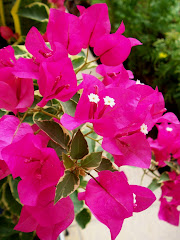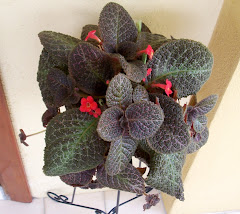
Apr 28, 2009
Herbs! A cook's best friend

Apr 19, 2009
Upclose & personal with the hatchlings
Busy pair of Long-tailed Tit (excited parents) (refer Update Jun-13,'09) flying to & fro - in every 5 minutes average, each bringing food (small insects) to feed their young hatchlings. Starting wee hours of morning until sunset. Phew! It's a tiring work!
A close-up of one of the hatchlings, with formed wings (hatched a week before), tried flapping in restlessness, while its eyes still closed. Ever-hungry and waiting anxiously for food.
We're guessing the growing hatchlings could learn to fly in another 2 weeks.
Update Jun-13,'09: Wonder what it is like at night? This guy is superb; he videotaped its nest at night. Watch how quite & still the Tailorbird on video 'Tailorbird Nest III'. Spooky eh? http://www.youtube.com/watch?v=c5fH4znW6t0
Tailorbird @home with Us
Update Jun-13,'09: It is Common Tailorbird (Orthotomus sutorius), not Long-tailed Tit - typically found in shrubs and gardens. Tailorbirds get their name from the way their nest is constructed (the edges of a large leaf are pierced and sewn together with plant fibre or spider's web to make a cradle) in shrubs. It lays 3–5 eggs. http://en.wikipedia.org/wiki/Common_Tailorbird
Tailorbird grows to about 13 cm (about 5 in) in length and feeds primarily on small insects. Its characteristically stitch leaves together with plant fibers to make nests - stabs the edges of one or more broad leaves with its needlelike bill, threads vegetable fibers through the holes, and draws the leaves together, making a cuplike pocket. The nest is lined with grass or other soft material. The female typically lays three to six eggs. http://encarta.msn.com/encyclopedia_761587895/Tailorbird.html
------------------------------
A close up of Tailorbird returning to its nest-in-making (Apr-4). We're updating its name, suppose to be Common Tailorbird instead of Long-Tailed Tit (Jun-13).


Spotted a couple of eggs, size about sen 50 - (Apr-6)
If you're wondering, a month ago, we've spotted a couple of Long-Tailed Tit (size 2-inch body with a tail 3-inch long) (refer Update Jun-13,'09), makes the loudest chirps - equivalent decibels to the ringing from an old fashioned alarm clock. It's amazing to think that loudness coming from a minute bird.
Long-tailed Tits (refer Update Jun-13,'09) are found in deciduous woodlands with significant undergrowth. This is a restless species, constantly on the move as it searches for insects and other small food items http://en.wikipedia.org/wiki/Long-tailed_Tit
This monogamous pair decided to nest amongst our shrubs (2-3 feet tall); stealing our coco-peat from our "Sui Mui" (Water Jasmine) pot - see video up-close with Long-Tailed Tit (refer Update Jun-13,'09)
It guards its nest by distracting suspected predators (or any moving objects, e.g. human being like myself) towards itself. Chirping ever loudly from a distant tree. It certainly wakes up the neighbourhood street!
We're so excited having newcomers (baby Long-Tailed Tit (refer Update Jun-13,'09)) yet it can be so annoying when I am weeding and clearing the flower-beds for hours.
Long-tailed tits join top ten in RSPB Big Garden Birdwatch survey http://www.timesonline.co.uk/tol/news/environment/article5970549.ece
Close-up of a bird perched (on our front fence) for as long as 30 minutes - observing, listening, twitching, scratching, etc. Emmotions shown through its head actions. Such a darling!
I wished to know the name of this bird.
Update Jun-13,'09: It is called It's called Yellow-vented Bulbul (Pycnonotus goiavier). Somehow we couldn't tell if it has a yellow bottom on this video clip *grins.
It is found in a wide variety of open habitats, but not deep forest. It is one of the most common birds in cultivated areas. They appear to be nomadic, roaming from place to place regularly.
The Yellow-vented Bulbul builds a well-camouflaged but fragile, loose, deep, cup-shaped nest from grass, leaves, roots, vine stems, and twigs. The nest is untidy on the outside, but it is neatly lined with plant fibers. it may be built in a wide range of places from low bushes to high trees. This is a species adapted to humans and may even nest in gardens. The Yellow-vented Bulbul lays 2-5 eggs in February to June. They eat berries and small fruits. They also sip nectar, nibble on young shoots, and some insects.
http://en.wikipedia.org/wiki/Yellow-vented_Bulbul
"Spring would not be spring without bird songs" - Francis M. Chapman
"A bird does not sing because it has an answer. It sings because it has a song" - Chinese Proverb
"Use those talents you have. You will make it. You will give joy to the world. Take this tip from nature: The woods would be a very silent place if no birds sang except those who sang best" - Bernard Meltzer
Apr 18, 2009
Foldable Plant Support

This new plant support c/w flexible horizontal wires; you can shift the wires according to the height of plant or as you wish. Comes in green that camourflage with the surrounding. I highly recommend this to Periwinkle-lovers.
Pretty Episcia, grown bushier as compared to a month ago;
Madagascar periwinkle, grown 2-3 inch above soil level after 2 weeks.
It is now 4-inch tall above soil level, to see 2 weeks ago at http://jaimeboey.blogspot.com/2009/04/gardening-humbling-experience.html
Apr 14, 2009
Burst of freshness - Roses Revival

 Sprout of new growth - Choon's roses, while we were away. Transplanted 2 months ago - pic.3 scraggly and cramped in a white pot before the transplant.
Sprout of new growth - Choon's roses, while we were away. Transplanted 2 months ago - pic.3 scraggly and cramped in a white pot before the transplant.Perhaps a bigger terracota pot, sufficient fertilizing, waterings during early mornings and late evenings, and trimmings; to nourish it to better health.
 A month had passed, yet it stayed the same, scraggly, with 1 or 2 discoloured blooms at a time. Wondered if we over-fertilized?
A month had passed, yet it stayed the same, scraggly, with 1 or 2 discoloured blooms at a time. Wondered if we over-fertilized?I was about to give up hope, 'lo and behold', a delightful sight of succulent fresh green and sturdy stems branching out its marroonish leaves (larger than its existing leaves). A burst of freshness.
Apr 11, 2009
Penang's Song River & Gurney


Captivated by Evergreen Laurel's landscaped garden, more so the manner of display of shrubs; e.g. Ever-red shrubs against the greens, bright-striking heliconias, silver-leaves shrubs and vertical fan-palms. It all glow colourful during full sun exposure (UV rays) - so tidy and well-trimmed. Now this is what I call - a 'picture perfect'.








Apr 1, 2009
Gardening a humbling experience


"Find the seed at the bottom of your heart and bring forth a flower".- Shigenori Kameoka
The 4th batch of Episcia, 3 x 5" black pot - recent cuttings transplanted; currently in a mini-nursery for 2 weeks with limited waterings, minimal sun exposure. Crispy and sturdy leaves, new growths from its main stem and new buds signifies survival (usually a month after repotting). Later, these matured Episcia will be transplanted into a planter-box to decorate the window-sill. [Updated May-2, 2009]
- 1st-watched closely as landscaper transplanted it but my over-watering killed it in a week.
- 2nd-made poor choice on cuttings in Nov however one cutting survived, 2 months later it bloomed.
- 3rd-gave away 3 pots in Feb, leaving one which didn't seem to do well at first, progressing slowly. [Update May-1,'09] It finally bloomed!
- And lastly the 4th-a plan to fill up the window-sill spot.

























